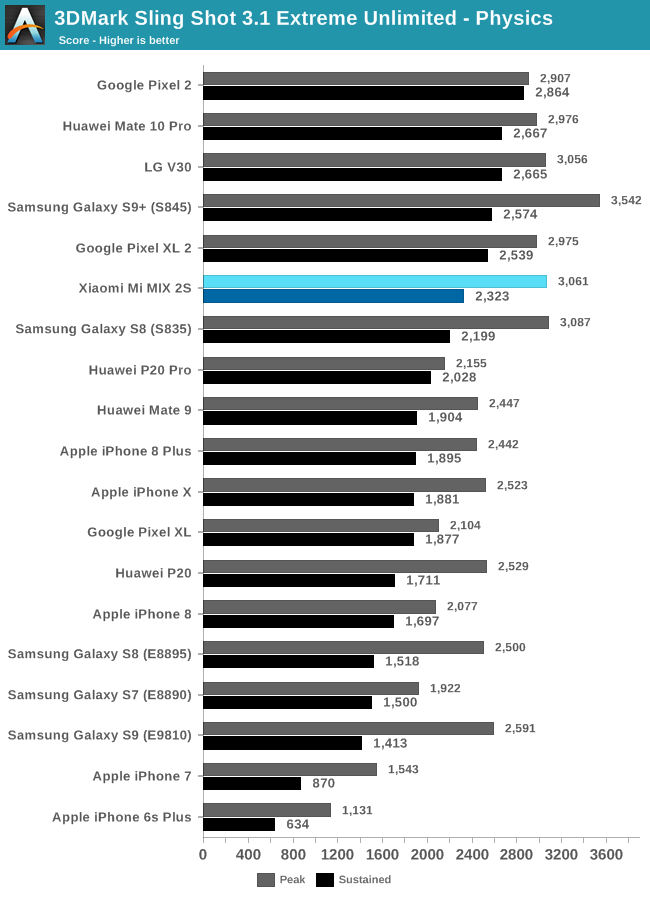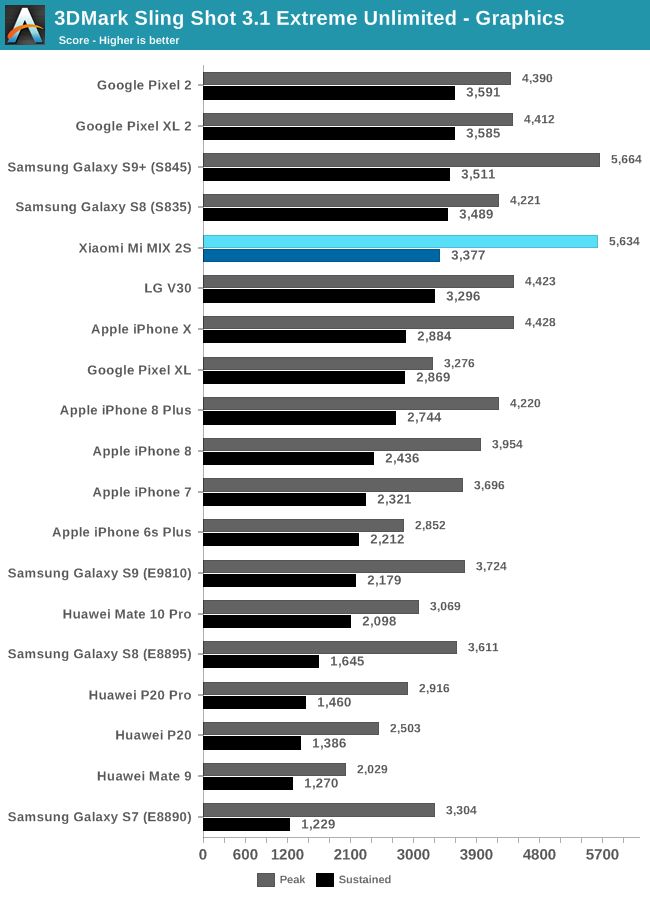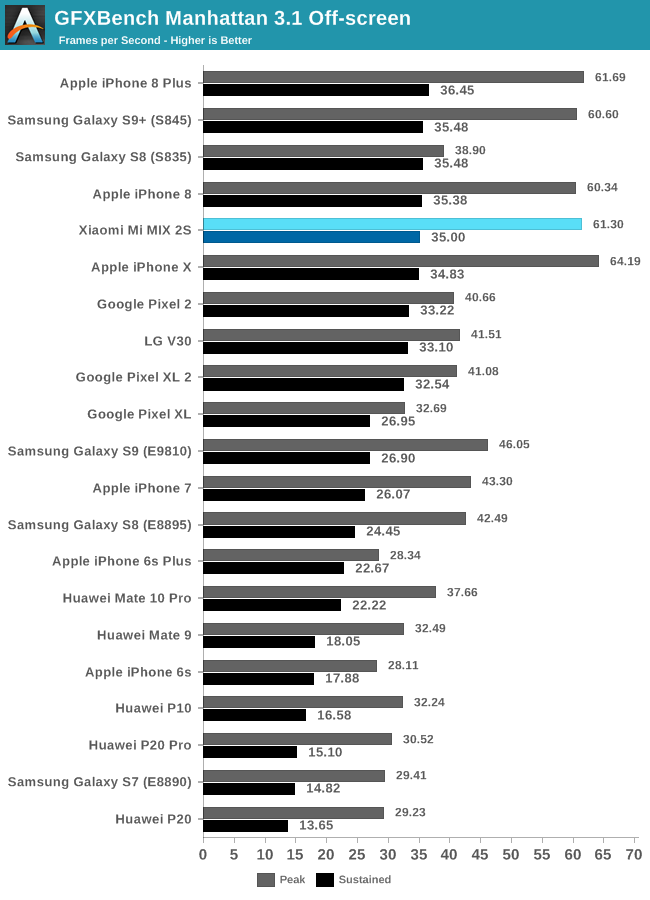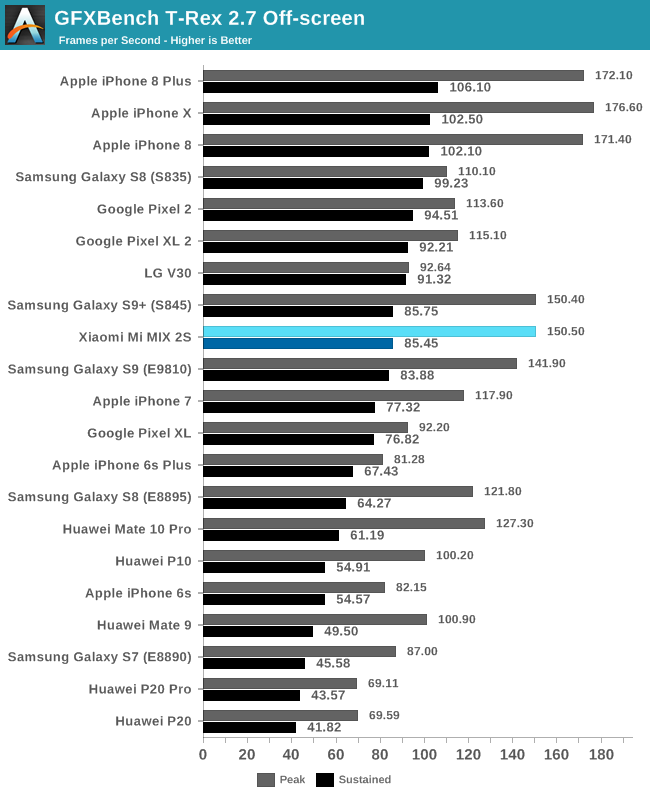The Xiaomi Mi MIX 2S Review: Fantastic Overall Value
by Andrei Frumusanu on June 29, 2018 8:00 AM EST- Posted in
- Mobile
- Smartphones
- Xiaomi
- MI MIX 2S
GPU Performance
On the GPU performance side, I’m expecting again very good results as we’ve investigated the performance of the Snapdragon 845 and the Adreno 630 GPU in depth in our Galaxy S9 review. The Mi MIX 2S should not differ too much from the S9 – apart from maybe slight differences in thermal dissipation capabilities or maybe different thermal throttling configurations.

In Futuremark’s Sling Shot 3.1 Extreme Unlimited Physics test (I’m hoping for shorter benchmark names in the future), the Mi MIX 2S actually performed quite a bit less than the Galaxy S9+. This test is mostly CPU bound, and the only explanation I have here for the results is that Xiaomi must have had made changes to the thermal balance between CPU and GPU and limited the CPU performance more in 3D workloads.

In the graphics score results of the test, the MIX 2S performed a lot closer to the Galaxy S9, posting identical peak performance figures while having only slightly slower sustained performance. Unfortunately we’ve verified both with a second Galaxy S9+ as well as now with the Mi MIX 2S that the sustained performance degradation of the Snapdragon 845 was not an isolated case. This makes sense given that the increased peak performance of the Adreno 630 seems to have come from increased power draw, exceeding the 5W figure in ALU heavy workloads. As naturally phone thermal envelopes can only sustain 3-3.5W SoC TDPs, performance has to go down over time to keep temperatures in check.

Manhattan 3.1 Off-screen performs again nearly identically to the Galaxy S9+, topping the benchmark scores.

T-Rex also matches the Galaxy S9+. The performance of the S845 devices here seems to be lower as the benchmark is running at high fps figures and demanding a lot of memory bandwidth – it’s possible that the increased memory latency on the S845 chips is hindering the performance and efficiency of the chip compared to the S835 in this case.
Overall, in terms of 3D performance the Mi MIX 2S leaves little complain about. While the increased peak power is of a concern, I’ve only found few games and real scenarios where the higher GPU frequencies are actually currently needed. Over the coming months I’m also planning to expand the GPU testing methodology and among other things try to introduce a “real game” battery or power draw test that doesn’t actually require peak performance, but rather maximum efficiency for a given workload. We’ll also hoping to introduce Vulkan GPU tests from Kishonti as well as evaluating the recently announced Basemark GPU.










61 Comments
View All Comments
nathanddrews - Friday, June 29, 2018 - link
Definitely seems like a great value, but I know I couldn't buy it without an OLED screen. How close to a stock experience does MIUI 9 provide? It doesn't look very intrusive at all, I like it.Andrei Frumusanu - Friday, June 29, 2018 - link
I'll be adding a software section in a short while - I've had zero issues with MIUI 9.5. Xiaomi also offers quite a novel gesture navigation method that works really well and gets rid of the navigation bar creating more screen real estate.Flunk - Friday, June 29, 2018 - link
It's not that novel, OnePlus offers a similar feature.close - Saturday, June 30, 2018 - link
Yeah, BlackBerry really used gestures a lot since the beginning of this decade, Apple took them and made them famous with the iPhone X, but now they are no longer novel because OnePlus/Android also copied them in 2018? :)arashi - Sunday, July 1, 2018 - link
You mean Nokia? With the N9?arashi - Sunday, July 1, 2018 - link
*that pioneered extensive gesture navigationSamus - Sunday, July 1, 2018 - link
Palm beat virtually everyone by a number of years to the gesture game. Give credit where credit is due. WebOS revolutionized mobile OS navigation and virtually every OS since had borrowed almost everything from multitasking cards to an information "hub" from WebOS.On top of all that, Palm beat Apple to wireless charging by an entire DECADE (unless you consider the Apple Watch, which by that means Palm beat them by 'just' 7 years.) Palm's wireless charging implementation was also significantly better than Qi from more efficient charging current (excluding Qualcomm high voltage fast charging) to magnetic alignment.
Lord of the Bored - Sunday, July 1, 2018 - link
But if we give credit where it is due, we can't give credit to Apple instead!piroroadkill - Monday, July 2, 2018 - link
It's actually kind of depressing to anyone who owned a Palm device with wireless charging how shoddy current wireless technologies are, and how few devices actually support it. The Pre and the Touchpad charged without any hassle whatsoever.hbsource - Monday, July 2, 2018 - link
Well, kind of.The little stand for the Pre was great but my screen always remained powered up while charging. The screen would be dark and blank but that was still more than enough to illuminate a dark bedroom.
The OS was very good but the hardware was definitely shonky. My keyboard rubber literally wore through to the metal below and I had a couple of incidents where I lost all the stored data and photos.
Could have been great but wasn't quite.